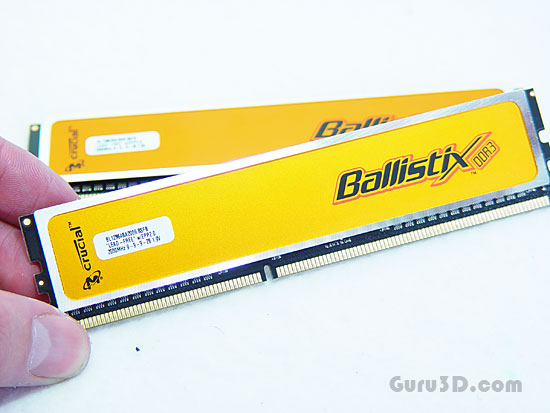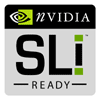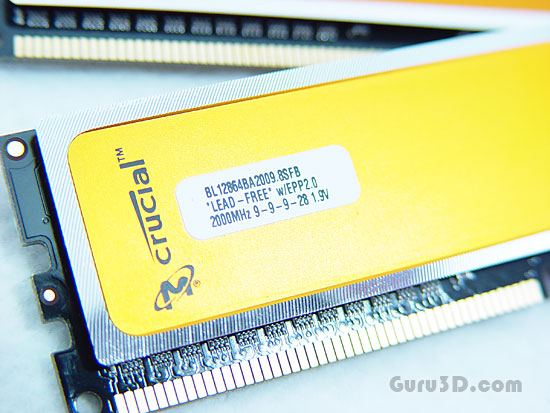3 - DDR3 Memory
DDR3 memory
Obviously one of the more prominent features of the nForce 790 series is the support for DDR3 memory. One of the bigger bottlenecks for a processors is actually memory bandwidth. What's memory bandwidth, you ask? Memory bandwidth is the actual rate at which data can be read or written into the memory by a processor.
Three factors are really important with memory bandwidth, bus width and frequency. The width of the interface (64-bits or 128-bit in dual-channel mode) or the frequency at which it transfers data. And then there's latency. DDR3 deals with the frequency mostly. See, any modern PC will likely run it's clock frequency at 667 or 800 MHz. With the Ultra version of the 790 mainboard and with some very expensive DDR3 memory, you are able to reach 2000 MHz and higher clock frequencies. That's a pretty drastic improvement. The nForce 790i Ultra SLI supports DDR3 memory at 2000 MHz straight out of the box, the nForce 790i SLI (without the Ultra) will offer DDR3 support up-to 1333 MHz.
Pretty exciting. You can understand though that dealing with such sensitive technology, overclocking will become increasingly different. That's why NVIDIA with the introduction of the 680 series launched EPP memory. And that's all about optimal memory frequency and timings (latency) setup at the flick if your fingers. Tweaking made easy. And that's where we land at version 2.0 of EPP.

EPP 2.0 A year and a half ago, NVIDIA released "SLI Ready" memory. A big success ever since the beginning. Personally I find it to be one of the coolest features of the nForce series. DDR2/DDR3 memory uses an SPD (Serial Presence Detect) chip to store its JEDEC certified timings and setup specifications on. Your mainboard reads this data and can setup the timings and voltages needed according to the memory specifications. Now a big part of that SPD chip on your memory is being written as ZERO; meaning it's largely unused space. That space is utilized it for you guys and offers better and more easy to use memory tweaks.
A year and a half ago, NVIDIA released "SLI Ready" memory. A big success ever since the beginning. Personally I find it to be one of the coolest features of the nForce series. DDR2/DDR3 memory uses an SPD (Serial Presence Detect) chip to store its JEDEC certified timings and setup specifications on. Your mainboard reads this data and can setup the timings and voltages needed according to the memory specifications. Now a big part of that SPD chip on your memory is being written as ZERO; meaning it's largely unused space. That space is utilized it for you guys and offers better and more easy to use memory tweaks.
See, JEDEC specifications are standard timings, not exactly enthusiast presets. As most of us know, we can do a heck of a lot more with memory timings and frequencies than the rather safe JEDEC SPD settings your BIOS uses by default.
Once you overclock the system bus, your memory clock will run faster in MHz as well. A higher FSB usually means that we'll need slower timings and/or different voltages, and that kind of information could be stored into the SPD in several profiles.
So basically, additional non-JEDEC specified timings related towards a certain clock frequency or related to multipliers/dividers/voltages/drive strengths will be stored on that unused SPD space. This way that memory can be setup in a different way with the click of a button, or even better: Detected by your nForce 790i mainboard and set automatically. Now this is why you see NVIDIA slapped all over the memory; "SLI Ready" is a feature that can be found on the more expensive Series 6/7 NFORCE products from NVIDIA.
Ever since it was introduced, EPP (or SLI Ready memory) has been a success in the enthusiast market. With the introduction of nForce 790 comes EPP 2, the next generation of the commonly accepted EPP 1.0 specification, in short it's delivering better performance with DDR3 memory. NVIDIA nForce 790i Ultra SLI motherboards support EPP 2.0 modules that can run natively at 1,600 MHz, 1,800 MHz, and 2,000 MHz.
Now when you boot for the first time the mainboard will post at 1333 MHz on the DDR3 memory, this is the JEDEC specification. You'll actually need to go into the BIOS, and tag the EPP 2.0 option. It's a fool proof method of getting the best out of your DDR3 memory with a 790 mainboard. Obviously you can manage memory timings and everything related to it manually as well. This is just an extra feature. But EPP / EPP 2.0 is a good development.

We will be testing with Crucial Ballistix 2000 MHz 9-9-9-28 @ 1.9V. This memory hasn't even been announced yet and obviously this Ballistix line is specifically built for performance enthusiasts who want to push the performance envelope. It's EPP 2.0 ready and as we'll show you in our benchmarks later, rather sexy.
